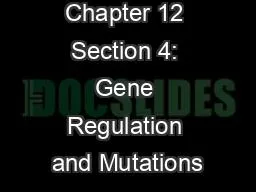

Main idea Gene expression is regulated by the cell and mutations can affect this expression Gene Regulation Cells have the ability to control which genes are transcribed and when they are transcribed ID: 920283
Download Presentation The PPT/PDF document "Chapter 12 Section 4: Gene Regulation an..." is the property of its rightful owner. Permission is granted to download and print the materials on this web site for personal, non-commercial use only, and to display it on your personal computer provided you do not modify the materials and that you retain all copyright notices contained in the materials. By downloading content from our website, you accept the terms of this agreement.
Slide1
Chapter 12 Section 4: Gene Regulation and Mutations
Main idea: Gene expression is regulated by the cell, and mutations can affect this expression
Slide2Gene Regulation
Cells have the ability to control which genes are transcribed and when they are transcribedSwitching genes “on” and “off”
Depending on cell, some genes are always off (skin cell vs. muscle cell)
Slide3Mutations
Mutation – change in an organism’s DNAHow?Naturally – mistakes in replication (RARE…why?)
DNA Damage – as a result of environmental factors
Slide4Slide5Sources of Mutations
Spontaneous – rare, naturally occurringPhysical – Radiation: UV, X-Ray, etc.Chemical – nicotine, asbestos, alkaloids, amines
Biological – viruses (HPV, Epstein-Barr)
Mutagen = substance which can cause mutations
Effects of mutations can range from no impact, to illness, to death
Slide6Slide7Types of Mutations: Genes or Chromosomes?
Chromosomal MutationsDuplicationTranslocation
Inversion
Deletion
Gene Mutations
Point Mutations
Substitution
Silent/Missense/Nonsense
Deletions/Insertions
Cause Frameshifts
Slide8Point Mutations (Substitution)
Substitute one nucleotide for another, resulting in a new codon3 Outcomes:Silent
Missense
Nonsense
Slide9Point Mutation: Silent
Two Results:Codon codes for the same amino acidCodon codes for an amino acid that does not affect the structure of the protein – NO CHANGE IN FUNCTION!
We are unaware of these mutations
Serine
UCG
Point Mutation
Changes
G►A
Serine
UC
A
Slide10Point Mutation: Missense
Result:Base change causes a different codon, which codes for a different amino acidChange affects that area of protein and likely alters function
Serine
UCG
Point Mutation
Changes
U►A
Threonine
A
CG
Slide11Sickle-Cell Anemia
Missense Mutation ExampleA single nucleotide change causes a missense point mutation that results in abnormally folding proteins and deformed red blood cells.
Slide12Point Mutation: Nonsense
Base change causes a stop codon, which terminates translation earlyThis causes an incomplete protein to be produced; the resulting protein is non-functioning
Serine
UCG
Point Mutation
Changes
C►A
STOP CODON
U
A
G
Slide13Cystic Fibrosis
Nonsense Mutation Example
A single point mutation in the gene sequence causes a stop codon to be coded for in the middle of the mRNA sequence. The effects of CF are catastrophic, including coughing, wheezing, excess mucus in lungs, risk of lung infection, and early death
Slide14Frameshift Mutations
Disrupt normal codons by adding or removing bases, thus “shifting” the reading “frame” during translationInsertion – extra base addedDeletion – removal of base
These mutations cause all amino acids down the line to be incorrect or missing
Slide15Chromosomal Mutations
Inversion – segments of chromosomes are inverted (flipped)Duplication – duplicated parts of chromosomes
Deletion –
missing parts of chromosomes
Translocation – segments of chromosomes exchange parts
Slide16Slide17Body-Cell vs. Sex-Cell Mutations
Body (somatic) cell mutations – occur in cells of body and are not passed on to childrenSkin, nerve, heart, kidney, etc.Sex (germ-line) cell mutations – occur in sex cells and may be passed down to children
Sperm or egg
Slide18Polar Bears and Brown Bears
Polar Bear Evolution
Slide19Slide20Teenage Mutant Ninja Turtles....????